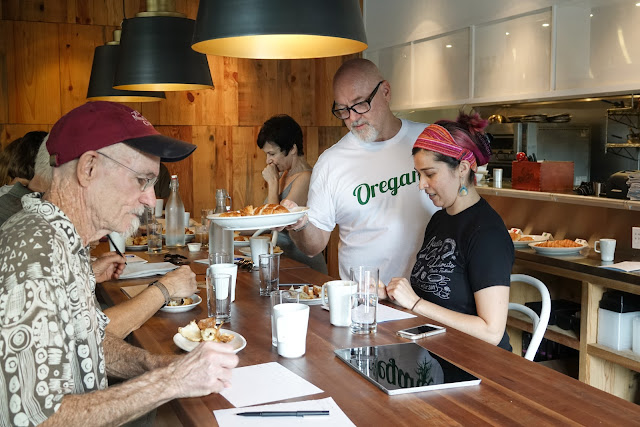Croissant Trio from Pieous, Dripping Springs, Texas.
I woke up this morning, gulped down a cup of hot Irish Breakfast tea with milk and a tiny bit of sugar and headed out the door for the 8:30-10:00 a.m. Masters Swim Practice. I was a few minutes late getting to the deck and when I got there all the medium pace lanes were filled up. I ended up sharing a lane with a notoriously dedicated triathlete whose workout philosophy is harder, faster, better. She dragged me through 4800 yards and I was spent by the end. Feeling virtuous but physically spent.
Afterward fellow swimmer, Emmett Fox, asked me if I had my camera (yes, always) and reminded me that we'd be forsaking our mundane local Starbucks for after-swim coffee in preference for a morning at Cantine Italian Cafe And Grill. Emmett and swimming spouse ( partner of one who swims... ) Dr. Jim Grubbs were going to host a tasting event to decide, once and for all, which bakery had the best croissants in all of Austin. No burnt coffee and refrigerated pastries at Starbucks this week!
Cantine, the restaurant, is closed on Saturday morning so we had the entire place to ourselves. Jim and Emmett had put together a selection of eight candidates from favorite local bakeries, as well as one mystery entry, the identity of which we discovered at the end. They put out three each of the croissants on nine plates and numbered the plates. No one was told the provenance of the pastries until the tasting was over and the scores tabulated. The eight local candidates for butter and flour supremacy were from:
Baguette et Chocolat, Texas French Bread, Sweetish Hill Bakery, Easy Tiger Bakery, Cafe No Sé (S. Congress Hotel), La Patisserie, Elizabeth Street Cafe, and a bakery near chef Emmett's home in Dripping Springs --- Pieous.
We tasted in small amounts, clearing our palettes with wonderful, stout coffee (thanks Cantine!) and we made notes and rated each entry on a scale of 1 to 5. The results were tabulated and the winner (by consensus) was Pieous Bakery from Dripping Springs. The very, very close second was the entry from Café No Se.
I brought a Sony RX10iii camera along and made images of our encounter with good food. It was a fun way to spend a toasty and humid Saturday morning; swilling coffee in the air conditioned comfort of one of Austin's best restaurants while chewing on croissants. Especially fun for me as I had my camera in my hand.
So, the surprise inclusion, made, I am sure, tongue-in-cheek, was three croissants that Jim bought in the frozen section at the local Trader Joe's Market. He took them home, followed the baking instructions and included them in the artisanal mix. Anonymity didn't matter, even the least discerning in the group was able to understand the difference in texture and overall taste. Like one other in the group the Trader Joe's version had added sugar, which we believe D.Q.'s it from being "authentic."
We disbanded and went our separate ways, planning to meet for next week's coffee at Cafe No Se.
An earlier motion to move to McDonalds was roundly vetoed.
Why the move from Starbucks after 15 or so years? Easy, they remodeled the local store and did an incredibly bad job with the remodel. It is much louder, the overall seating was reduced and the seating that is left is almost impossible to configure for any group of more than four. The final straw is the chain's new devotion to costumer confusion. They changed the flow and now no one knows how or where to line up to order their stuff. Instead of a line you get a confused group of people who would dearly love to get coffee but have no idea of who is next or why. No signage. No stantions. No directional supports. It's very sad when companies make customer experiences meaner and dowdier. And whoever sold them the pin spot LEDs that shine in everyone's eyes, no matter where they sit, did no favors to people who are sensitive to good lighting and/or good design. Next time they remodel they might consider hiring architects, or at least consider keeping the ones they use (if they did) sober and rational. So there is a basket of good reasons to shun this member of the chain and search out better. local providers. My advice? Short the stock...especially if all their remodels turn out as poorly as this one did...

#5. My personal favorites for flavor and texture. From No Sé at the South Congress Hotel.
The overall winner.
The runner up. By a nanometer.
Our host was Cantine; my favorite South Austin restaurant. Renowned for their great pizzas.
Emmett preparing the blind taste test.
Martha takes notes.
Rating for appearance.
Incidentally, Pieous wins for best appearance.
discussing the fine points of baked goods.
The Co-Captains: Dr. Jim Grubbs and Restauranteur, Emmett Fox.
Lisa Fox (co-owner, Cantine) slices croissants into sample sized servings.
Patty and Jim get serious with their evaluations.
Stout and virtuous, free flowing coffee to cleanse our palettes between samples...
We rated on both texture and taste.











































































